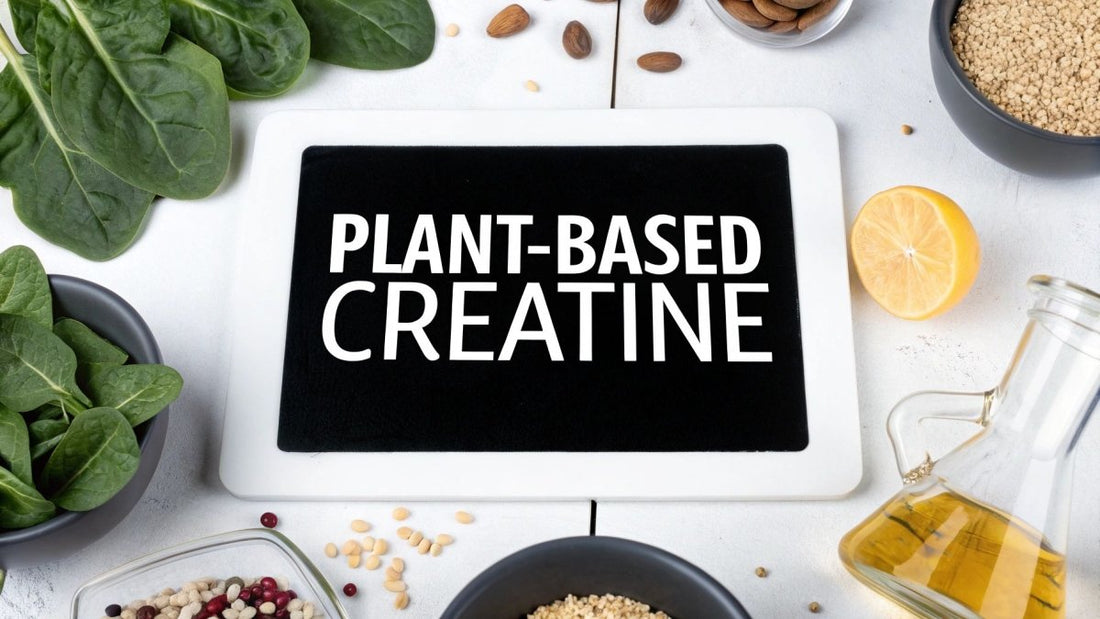
Your Guide to Creatine Plant Based Supplements
Share
Let's get one thing straight right from the start: all supplemental creatine is synthetic. It's made in a lab, not sourced from animals, which technically makes it vegan-friendly by default.
So, when you see a label that says creatine plant based, what does that actually mean? It’s less about where the creatine itself comes from and more about providing a guarantee for the entire product. It’s a signal to conscientious consumers that everything inside that container—from the powder to the capsule it might be in—is completely free of animal derivatives.
Unpacking the “Creatine Plant Based” Label
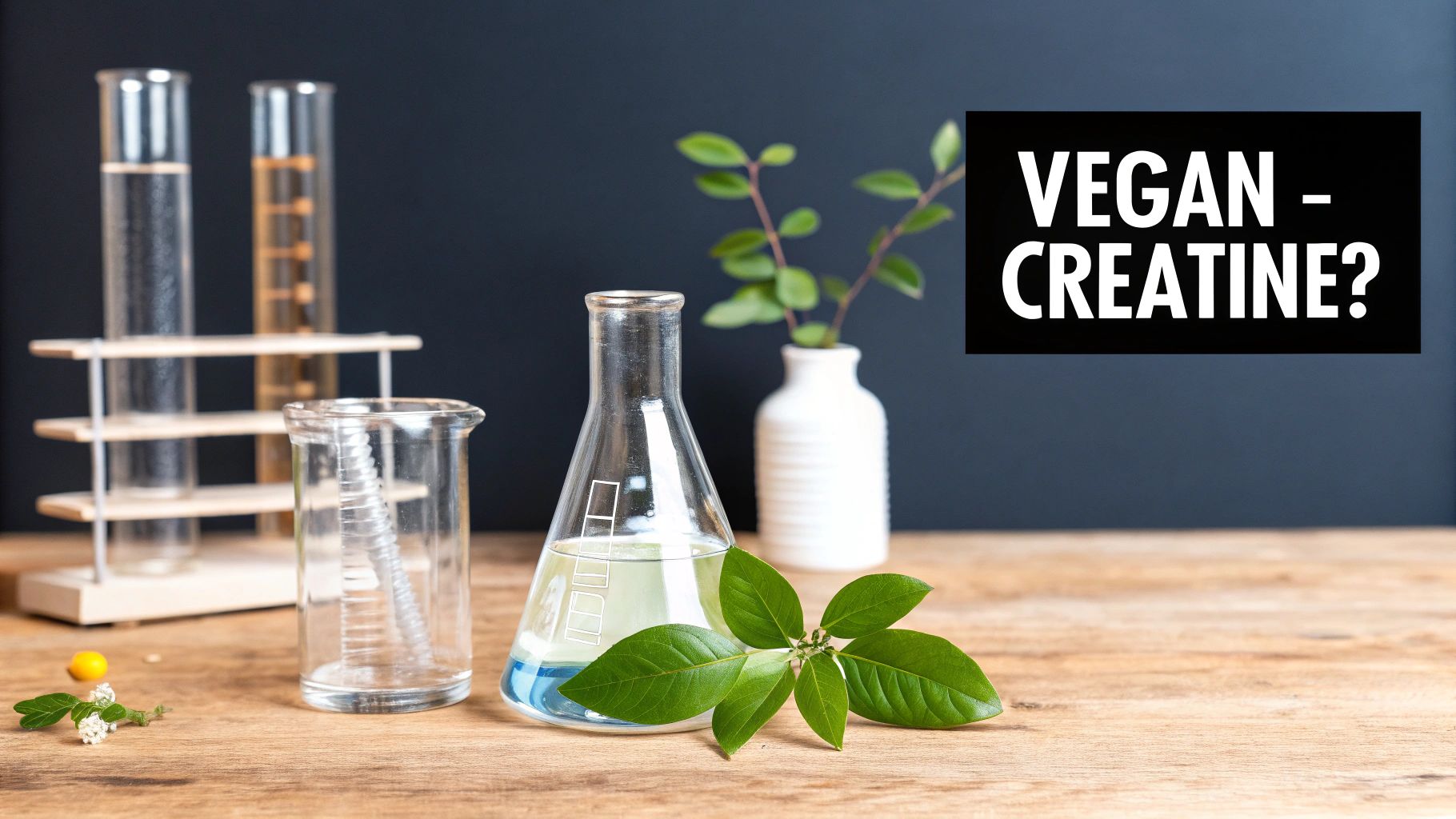
Think of the "plant-based" or "vegan" sticker on a creatine tub as an assurance, a seal of approval. The creatine molecule is the same whether it has that label or not. The real difference is that the company has gone the extra mile to ensure every single component aligns with a vegan lifestyle.
It’s a bit like the difference between a lab-grown diamond and a mined one. Chemically, they're identical. But for someone concerned with the ethical and environmental impact of mining, the lab-grown option offers peace of mind. The "vegan" label on creatine serves the same purpose.
Why This Distinction Matters
For anyone on a strict plant-based diet, this certification is non-negotiable. It’s the only way to be certain that no hidden animal byproducts have snuck into the formula. This is particularly important when you consider things like:
- Capsules: Many supplements use gelatin capsules, which are made from animal collagen. A vegan certification ensures plant-based cellulose (veggie caps) are used instead.
- Fillers and Binders: Any extra ingredients used to prevent clumping or to fill out a capsule must also be confirmed as non-animal derived.
- Flavorings: The certification guarantees that any added flavors come from plant or synthetic sources, not animal ones.
This consumer demand for transparency is making a huge impact. The U.S. creatine market was already valued at USD 419 million in 2024 and is expected to explode to nearly USD 1.92 billion by 2030. A big driver of that growth is the shift toward products that are clearly and honestly labeled as natural and plant-based.
Once you grasp this, you can see past the marketing spin. The goal isn't to find creatine "from a plant," but to choose a high-quality, pure creatine monohydrate from a trusted brand that certifies its entire formula as vegan. That's the key to understanding what does creatine do for your body in the cleanest way possible.
Why Vegans See the Greatest Creatine Benefits
Creatine is one of the most well-researched supplements out there, but here’s something you might not know: the benefits can be especially dramatic for vegans and vegetarians.
It all comes down to diet. The main natural sources of creatine are animal products like red meat and fish. If you’re on a plant-based diet, you’re simply not getting much, if any, creatine from your food. This means your body's baseline creatine levels are naturally lower. This isn't a bad thing, but it does create a unique opportunity when you start supplementing.
Think of your muscle's creatine stores like a gas tank. Someone who eats meat might start with their tank already three-quarters full. When they supplement, they're just topping it off—they’ll still feel a boost, but it’s a relatively small one.
A vegan or vegetarian, on the other hand, might be starting with their tank closer to half-full. Supplementing fills a much bigger gap, leading to a far more noticeable jump in energy, strength, and even mental clarity.
This infographic breaks down exactly why that performance surge can feel so significant for someone on a plant-based diet.
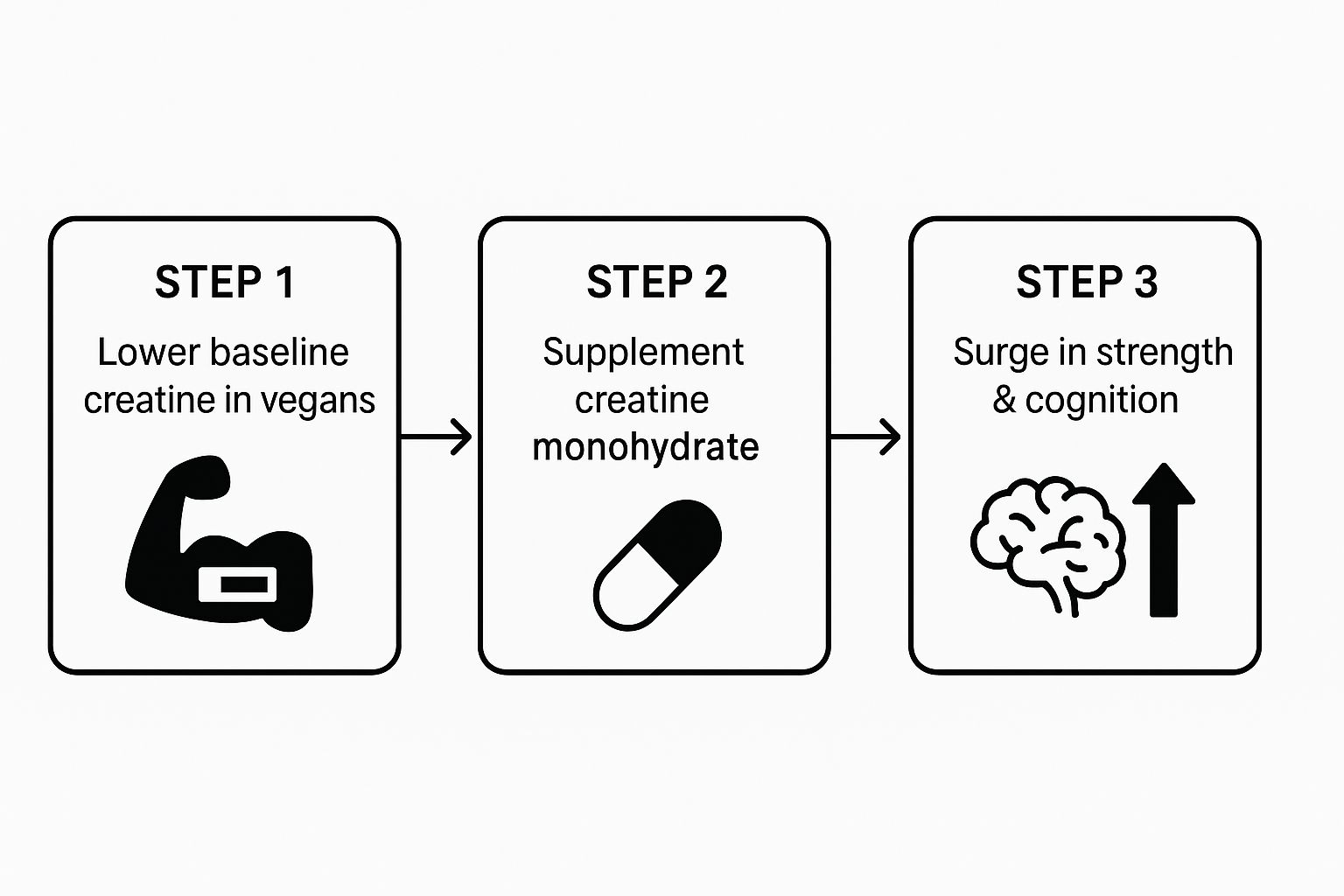
Ultimately, you’re taking your creatine stores from a lower starting point all the way up to full saturation. That’s where the real magic happens.
Magnified Physical Performance Gains
For anyone on a plant-based diet, adding a creatine plant based supplement can feel like flipping a switch. Your body's immediate energy system—the one that powers heavy lifts and sprints—runs on creatine. When you suddenly give it a full supply, the results speak for themselves.
- More Strength and Power: Time and again, studies show that vegetarians who take creatine see bigger gains in lean muscle and overall strength compared to meat-eaters doing the same training.
- Better Endurance: More available energy means you can crank out those extra few reps or hold your pace a little longer before hitting a wall.
- Quicker Recovery: Creatine also plays a role in reducing muscle damage and inflammation post-workout, helping you bounce back faster for your next session.
Amplified Cognitive and Brain Benefits
The impact isn't just physical. Your brain is a massive energy hog, and it also uses creatine to keep its cells firing on all cylinders. Since vegans start with lower baseline levels, the mental boost from supplementing can be just as impressive as the physical one.
Research has found that vegetarians who supplement with creatine show real improvements in cognitive tasks, especially those involving memory and intelligence. It’s a powerful reminder that creatine is just as crucial for your brain as it is for your biceps.
This translates to better short-term memory and quicker thinking. So, whether you're an athlete, a student, or a professional with a demanding job, a creatine plant based supplement isn’t just for the gym—it’s a fantastic tool for staying sharp and focused in every part of your life.
So, How Is Commercial Creatine Actually Made?
It’s a common assumption that creatine supplements must be derived from animal sources. After all, meat and fish are where we find it in our diet. But the creatine you scoop out of a tub takes a completely different journey—one that starts and ends in a lab, making the creatine molecule itself entirely free of animal products.
The process is surprisingly simple. Think of it like a recipe with just two main ingredients: sarcosine and cyanamide.
These two compounds are combined, heated, and pressurized inside a large reactor. This carefully controlled chemical reaction forces them to bond, creating the pure, white crystalline powder we know as creatine monohydrate. It's a clean, efficient, and entirely synthetic process that produces a molecule identical to the one in our muscles, with no animal tissue ever entering the picture.
The Science Behind Synthetic Creatine
This man-made method allows for an incredible level of purity and consistency—something that would be impossible if we tried to extract creatine from a natural food source.
Here’s a look at the chemical biosynthesis of creatine, which happens entirely outside of an animal.
As you can see, simple precursor chemicals are used to build the creatine molecule from the ground up.
This is a key point: when you see a "vegan" or "plant-based creatine" label, it's not describing the creatine molecule. Instead, it’s a guarantee that the other ingredients in the tub—like capsules, flavors, or flow agents—are also 100% free from any animal derivatives.
This distinction matters more than ever. The global market for creatine supplements, valued at around USD 639.7 million in 2025, is expected to explode to USD 2.17 billion by 2035, driven by consumers who want to know exactly what’s in their products. You can dive deeper into this trend in the market expansion report from Future Market Insights.
Why This Changes How You Shop
Once you know that all creatine is synthetic, you can stop worrying about its origin and start focusing on what really counts when picking a supplement:
- Purity: Is it third-party tested? Look for seals from reputable labs that confirm you’re getting pure creatine without unwanted contaminants.
- Form: Stick with what works. Creatine monohydrate is still the gold standard, backed by decades of research.
- Vegan Certification: This seal is your confirmation that no animal byproducts, like gelatin in capsules, were used to make the final product.
Ultimately, the debate isn't about where the creatine comes from. The real question is about the quality and integrity of the finished product you choose to put in your body.
How to Choose the Best Vegan Creatine Supplement
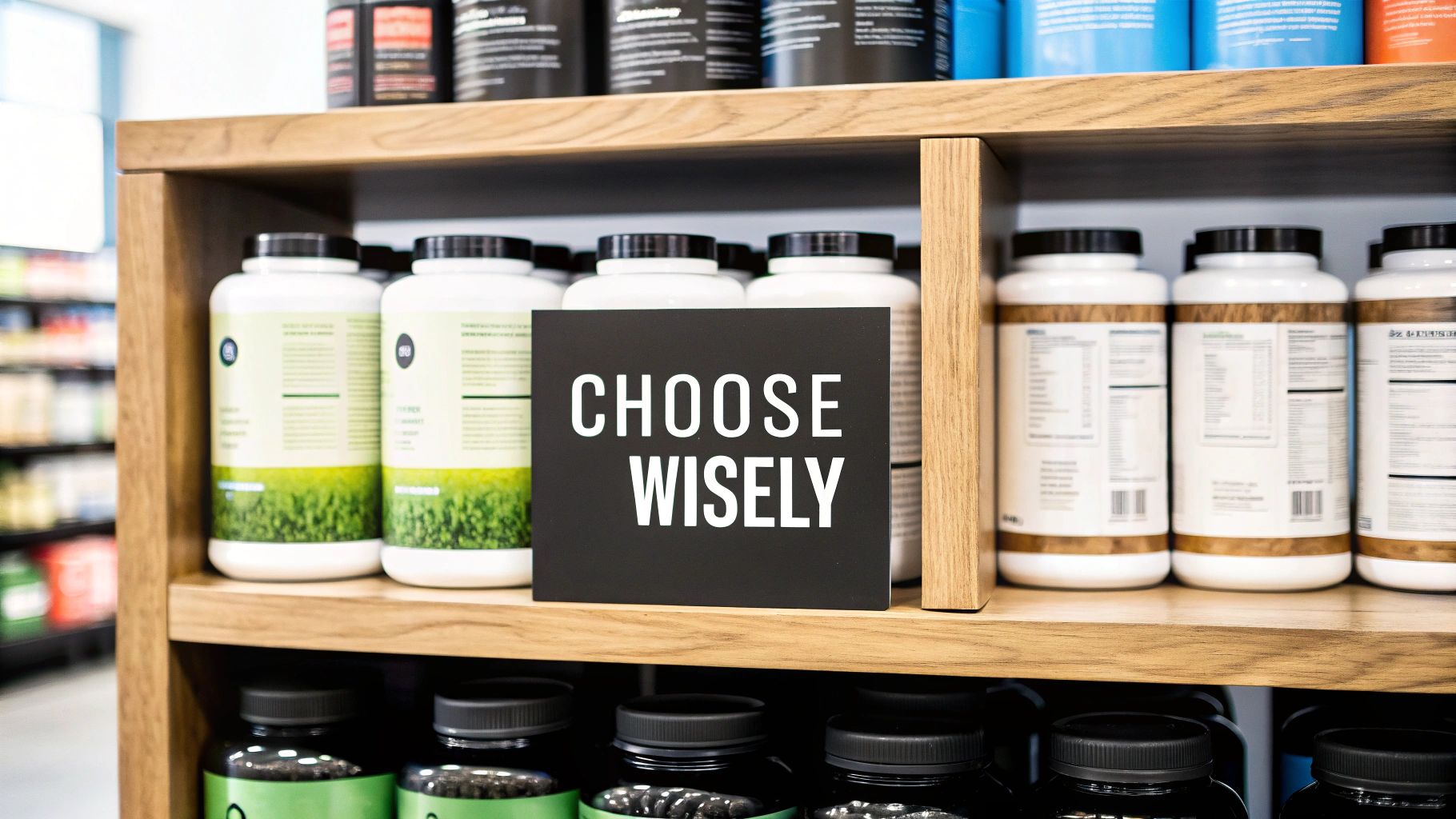
Walking down the supplement aisle can feel like a maze, especially when you're sticking to a plant-based lifestyle. Every label makes big promises, but how do you know which creatine is truly vegan and high-quality?
The secret is to ignore the flashy marketing on the front and become a bit of a detective, focusing on a few key details that signal purity and quality.
First things first: look for the right form of creatine. You’ll see a bunch of different types, but creatine monohydrate is the undisputed champion. It's the most researched, proven, and cost-effective form out there. We're talking hundreds of scientific studies backing its ability to boost strength, power, and even brain function. Don't get distracted by fancy, more expensive versions that just don't have the same level of evidence behind them.
Decoding Labels and Certifications
Once you've settled on creatine monohydrate, it's time to check for certifications. Think of these logos as a stamp of approval from an unbiased third party, confirming the product is exactly what it claims to be.
Here’s what to keep an eye out for on the packaging:
- Vegan Certification: This is your most important clue. Look for a trusted logo, like the Certified Vegan seal, which guarantees the entire product is free of animal-derived ingredients. This includes the powder itself, any capsules, flavorings, or other additives. It's the only way to be sure your creatine plant based supplement is genuinely plant-based.
- Third-Party Testing: A seal from a group like NSF Certified for Sport or Informed-Sport is a must-have. It means the product has been independently tested to ensure it’s pure, free from contaminants, and doesn't contain any banned substances. For any serious athlete, this is non-negotiable.
Choosing a certified product takes the guesswork out of the equation. It's your assurance that you’re putting something clean, safe, and effective into your body—not just paying for clever marketing.
Prioritizing Purity and Simplicity
Finally, take a look at the ingredient list. When it comes to creatine, simpler is almost always better. The best supplements have just one ingredient: pure micronized creatine monohydrate. The term "micronized" just means the powder has been broken down into smaller particles, which helps it dissolve better in water and can be gentler on your stomach.
Be cautious of products packed with unnecessary fillers, artificial sweeteners, or "proprietary blends" that don't tell you how much of each ingredient you're getting. Your goal is a clean supplement that does its job without any junk.
Navigating the world of supplements can be tough, but finding the right creatine doesn't have to be. To simplify your search, I've put together a quick checklist to help you spot a top-tier vegan product instantly.
Vegan Creatine Supplement Checklist
| Feature to Check | What to Look For | Why It Matters |
|---|---|---|
| Form of Creatine | Creatine Monohydrate (ideally micronized) | This is the most scientifically validated and effective form for performance and safety. |
| Vegan Integrity | A recognized Vegan Certification logo on the label | Guarantees that no animal products were used in the creatine or any other ingredients (capsules, fillers, etc.). |
| Purity & Safety | Third-Party Testing seal (e.g., NSF, Informed-Sport) | Verifies the product is free from contaminants, heavy metals, and banned substances. You get what you pay for. |
| Ingredient List | Minimal ingredients; avoid fillers, artificial flavors, and proprietary blends | Ensures you're getting a pure, effective product without unnecessary additives that could cause side effects. |
Using this checklist will help you cut through the noise and feel confident in your choice.
Ultimately, creatine monohydrate is often recognized as a foundational supplement for performance. It's a key player among the best supplements for athletes for good reason. By sticking to these simple guidelines—monohydrate form, vegan certification, and third-party testing—you'll have no trouble finding a high-quality product that aligns with your goals and your values.
Supporting Creatine Production with Plant Foods
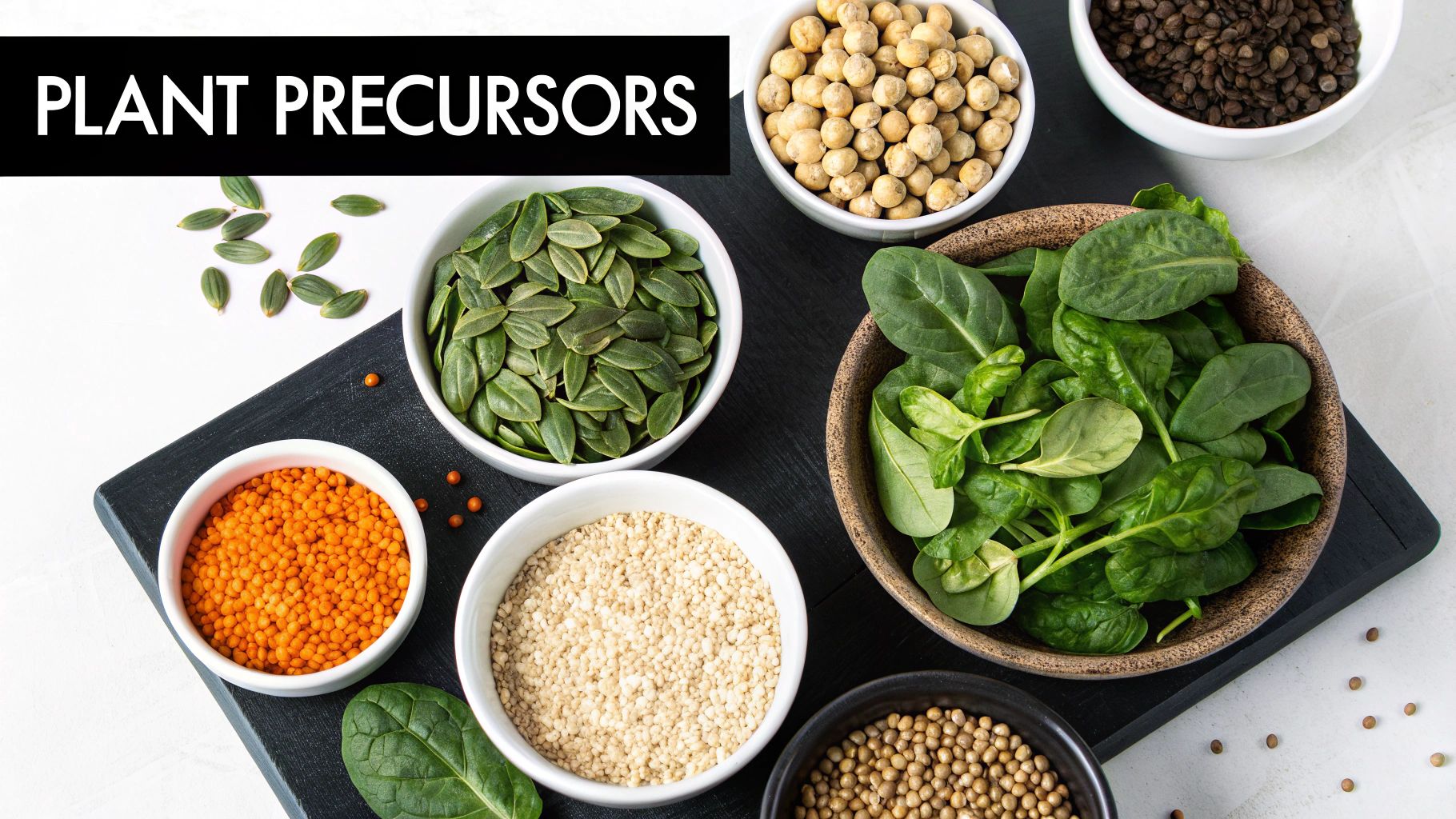
While it's true that no plant contains creatine itself, your body has a neat trick up its sleeve: it can make its own. Think of your body as a little creatine factory. Like any factory, it needs the right raw materials to get the job done.
In this case, the raw materials are three specific amino acids. By eating a diet packed with these crucial building blocks, you’re giving your body everything it needs to optimize its natural production. This food-first approach is a fantastic way to support your overall health and works hand-in-hand with a good supplement routine.
The Building Blocks of Natural Creatine
Let's break down the "recipe" your body uses. Your liver and kidneys are the chefs, and they combine three key ingredients to cook up creatine.
- Arginine: This is the foundational piece, often known for its role in blood flow, but it's also the starting point for creatine synthesis.
- Glycine: A simple but mighty amino acid that's involved in all sorts of metabolic processes, including making creatine.
- Methionine: This is the final touch. It completes the chemical structure, turning the precursors into a finished creatine molecule.
Stocking your diet with foods rich in these three compounds is the most direct, natural way to support your body's own creatine supply.
Top Plant-Based Sources
So, where can you find these building blocks? It's easier than you might think. The growing demand for clean, vegan-friendly nutrition has put a spotlight on powerful plant foods, and this is reflected in the growth of the natural creatine market. If you're curious about the industry trends, you can see some interesting market projections on Data Bridge Market Research.
Here are some of the best plant sources to add to your grocery list:
- For Arginine: Pumpkin seeds, peanuts, soybeans, chickpeas, and lentils are all powerhouses.
- For Glycine: Load up on spinach, seaweed, watercress, sesame seeds, and tofu.
- For Methionine: Tofu pulls double duty here, along with brazil nuts, quinoa, and whole-grain bread.
It's important to keep expectations in check. A nutrient-rich diet is incredibly beneficial, but it won’t raise your muscle creatine stores to the same super-saturated levels that direct supplementation can. Your diet supports your baseline, while supplements help you reach your peak potential.
This is why combining a solid diet with smart supplementation is a cornerstone of so many effective fitness programs. To learn more about how to fuel your body for peak performance, take a look at our guide on nutrition for strength training. When you nail both strategies, you’re covering all your bases and setting yourself up for the best possible results.
Your Guide to Creatine Dosage and Timing
Alright, let's talk about the best way to take your plant-based creatine. The good news is, it's not complicated. There are really only two proven methods that people use, and which one you pick comes down to how quickly you want to see results.
One popular route is called the "loading phase." This is all about saturating your muscles with creatine as fast as possible.
You’d take a higher dose—typically 20 grams per day—for about 5-7 days. To make it easier on your stomach, you'll want to split this into four separate 5-gram servings throughout the day. After that first week, you scale back to a simple daily maintenance dose of 3-5 grams.
The biggest advantage here is speed. You'll feel the boost in strength and performance much sooner. The only catch is that some people might experience a bit of stomach upset with the larger initial doses.
The Steady and Simple Approach
If you'd rather take it slow, you can skip the loading phase entirely. This second method is as simple as it gets: just take a consistent maintenance dose of 3-5 grams of creatine every day, right from the start.
This approach is much gentler and easier to manage. It will take a bit longer for your muscles to become fully saturated—usually about three or four weeks—but you'll end up in the exact same place. For most people, this is the most practical and sustainable way to go.
Want to dive deeper into nailing down your exact daily number? Check out our complete creatine dosage guide from beginner to expert results.
When it comes to creatine, consistency beats everything else. Forget about perfect timing or loading protocols if you can't stick to the basics. Taking it daily is what keeps your muscles topped off and ready to perform.
Now, while taking it every day is what truly matters, there might be a tiny edge to when you take it. Some research suggests that taking creatine post-workout with some carbs and protein could help your muscles absorb it a little better.
The idea is that the insulin spike from your post-workout meal helps shuttle the creatine into your muscle cells. But honestly, the effect is pretty minor. The most important thing is finding a time that works for you so you never miss a day.
Common Questions About Vegan Creatine
Even after getting the rundown on plant-based creatine, it's totally normal to have a few questions floating around. Let's clear up some of the most common ones so you can feel confident about adding it to your routine.
The biggest question I hear is about safety. Is vegan creatine safe to take for the long haul? The answer is a definite yes. Creatine monohydrate is one of the most researched supplements in existence, with decades of studies backing up its safety and effectiveness for most people. The "vegan" part just means no animal products were used in the process—it doesn't change the safety of the creatine molecule itself.
Does Plant-Based Creatine Cause Bloating?
This is another huge one. Some people worry about water retention or "bloating," especially when they first start with a high-dose loading phase. This happens because creatine pulls water into your muscle cells, which is actually a key part of how it works its magic.
But here's the thing: this effect is usually minor, temporary, and often not even noticeable. If you want to avoid it, just skip the loading phase and stick to a consistent, lower daily dose of 3-5 grams. Opting for a high-quality, micronized creatine can also make a difference, as it dissolves more easily and tends to be gentler on the stomach.
Remember, that water is going into your muscles, not just sitting under your skin. This is what gives you that full, hydrated muscle look and feel—it’s a good sign the creatine is doing its job!
Is It Suitable for All Vegan Athletes?
Absolutely. It doesn't matter if you're a bodybuilder chasing a new PR, a long-distance runner needing an extra kick, or a CrossFitter trying to crush your next WOD. Creatine has something to offer.
Its main job is to help your body quickly recycle ATP, which is the high-octane fuel for short, explosive movements. That means more power for your lifts, more speed for your sprints, and more endurance when you’re going all out. Since vegans and vegetarians naturally have lower creatine stores, the boost you feel can be even more dramatic across any sport. It’s one of the most versatile and proven supplements out there.
At the end of the day, a quality plant-based creatine is a safe and incredibly effective tool to have in your corner. It aligns perfectly with a clean, plant-focused lifestyle while giving you the performance edge you're looking for.
Ready to feel the difference without the chalky powder and messy shakers? Smash.com offers delicious creatine gummies, delivering a full 5-gram serving in every pouch. Made in the USA and third-party tested for purity, they're the easiest way to fuel your performance. Try Smash creatine gummies today!